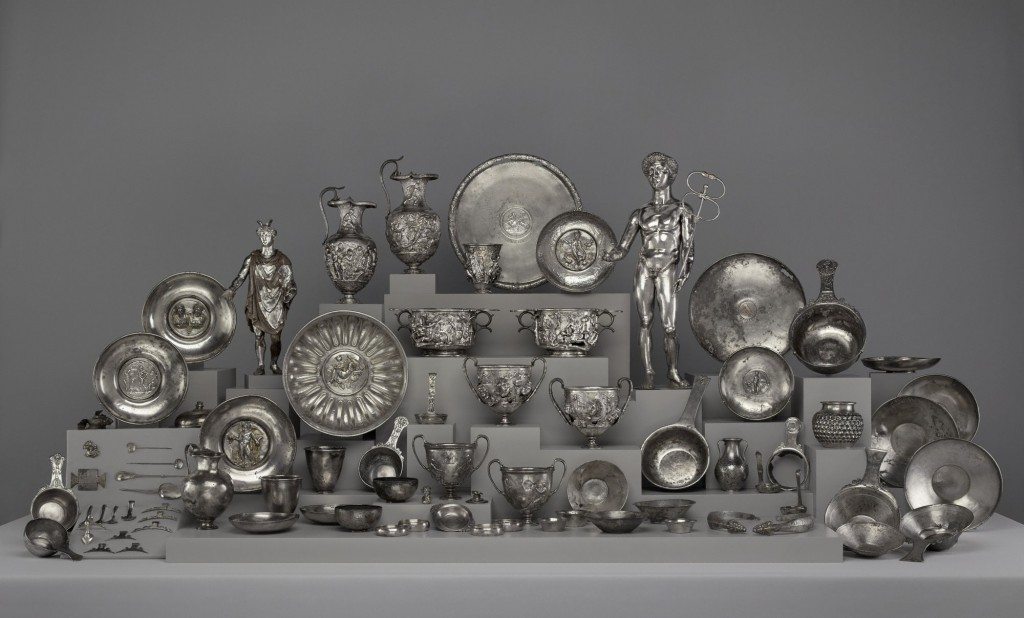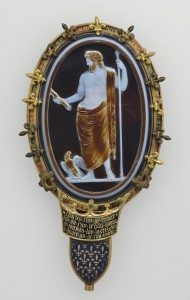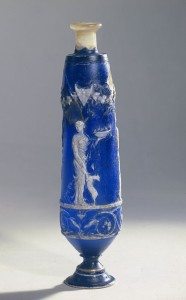
Mercury, 175 – 225. Roman. Medium: Silver and gold. Object: H: 56.3 x Diam.: 16 cm, Weight: 2772 g (22 3/16 x 6 5/16 in., 6.1112 lb.). D: 24 cm (9 7/16 in.). Accession No. VEX.2014.1.1. Bibliothèque nationale de France, Département des monnaies, médailles et antiques, Paris.
Accidentally discovered by a French farmer in 1830 CE, the spectacular hoard of gilt-silver statuettes and vessels known as the Berthouville Treasure was originally dedicated to the Roman god Mercury. Following four years of meticulous conservation and research at the Getty Villa in Los Angeles, CA, Ancient Luxury and the Roman Silver Treasure from Berthouville allows visitors to appreciate their full splendor and offers new insights about ancient art, technology, religion, and cultural interaction in Late Roman Gaul. James Blake Wiener, Communications Director at Ancient History Encyclopedia (AHE), learns more about this exhibition from Mr. Kenneth Lapatin, Associate Curator of Antiquities at the J. Paul Getty Museum, in this exclusive interview.

Cameo of Jupiter (The Cameo of Chartres), about 50. Roman. Sardonyx set in fourteenth-century gold and enamel mount. Object: H: 15.2 x L: 6.5 cm (6 x 2 9/16 in.). Accession No. VEX.2014.1.104. Bibliothèque nationale de France, Département des monnaies, médailles et antiques, Paris.
JW: Welcome to Ancient History Encyclopedia, Mr. Kenneth Lapatin! It’s an immense pleasure to be working with the J. Paul Getty Museum and the Getty Villa once again.
Ancient Luxury and the Roman Silver Treasure from Berthouville was organized by the J. Paul Getty Museum in collaboration with the Bibliothèque nationale de France, Département des Monnaies, médailles et antiques, Paris. How many years did it take to bring the entire treasure — consisting of approximately 90 ancient silver objects weighing over 50 lbs (23 kg) — to the Getty Villa in Los Angeles?
KP: Even before the Treasure arrived in Malibu in December 2010, there was a lot of discussion and planning about the project. Officials from the Cabinet des médailles of the Bibliothèque nationale de France, who have cared for the Treasure since it was discovered in rural Normandy in 1830, and Getty curators, conservators, registrars, and other staff had to agree on the scope and timing of the project, as well as the outcome, and then everything had to be prepared for shipment, packed, and sent across the Atlantic Ocean.
JW: Before Ancient Luxury and the Roman Silver Treasure from Berthouville opened, The J. Paul Getty Museum undertook a four-year project restoring the artifacts, cleaning away debris and tarnish, and researching their historical and cultural significance.

Perfume Flask with the Seasons, 25 B.C. – A.D. 50. Roman. Cameo glass with modern resin neck and enameled metal foot. Object: H: 15.5 x Diam. (foot): 3.2 cm (6 1/8 x 1 1/4 in.). Accession No. VEX.2014.1.172. Bibliothèque nationale de France, Département des monnaies, médailles et antiques, Paris.
Could you comment about this lengthy process of restoration and recovery, and how it set the stage for the exhibition? As I understand it, the nineteenth-century restoration proved detrimental to items in this treasure hoard. Why was this the case?
KP: It is, I think, important to distinguish between restoration, which often entails replacing missing parts of objects, from conservation, which involves cleaning, stabilizing, and ensuring the safety of objects. When the silver objects were first removed from the ground by the farmer who found them by chance in 1830, not only were they dirty with encrustations from having been buried for more than one and a half millennia, many of the complex items had also fallen apart. Ancient joins connecting the handles and feet to the bowls of cups had come loose, and decorative medallions were separated from many vessels.
So the early restorers not only scrubbed clean much of the hardened encrustations, often deeply scratching the silver, but they also reattached loose handles and feet with hard solder. Today, when conservators reattach loose or broken pieces, they do so with reversible adhesives, but this was not the case back then. So just as we could not undo the scratching and removal of ancient surfaces, we did not try to pry apart the very permanent reattachment of handles or medallions, even in those few instances where we think they were done erroneously.
JW: A few objects in the Berthouville Treasure bear Latin inscriptions stating that they were dedicated to Mercury by a Roman citizen named Quintus Domitius Tutus. What makes these artifacts so special and impressive compared to the others? Additionally, do we know anything about Quintus Domitius Tutus aside from that he was a man with an apparent taste for luxury goods?
KP: Quintus Domitius Tutus was one of several individuals whose name is recorded as a donor to Mercury at the ancient shrine that once stood at Berthouville. Other donors also had Latin names, but some were clearly locals, like Germanissa (the “German woman”), the daughter of Viscarius. Thus we know that there were Romans as well as locals, women as well as men, even freed slaves as well as the free born who worshiped Mercury. We have no other record about Tutus, and we really don’t know much about his taste. We do know that he came into possession of some exquisite silver, and he was quite generous about giving it to Mercury, but we don’t know much about his motivation, except what we are told by the inscriptions, which say he made his dedications “ex voto” — in fulfillment of a vow.
So if this is what they had in remote Gaul, what have we lost from the tables of senators and emperors in Rome!? In fact, some of the pieces found at Berthouville represent the best of surviving Roman silver — better than anything we have from Pompeii, Herculaneum, or anywhere else.

Beaker with Imagery Related to Isthmia and Corinth, 1 – 100. Roman. Silver and gold. Object: H: 12.6 x Diameter: 10.3 cm, Weight: 463 g (4 15/16 x 4 1/16 in.,
1.0207 lb.). Diameter: 4.7 cm (1 7/8 in.). Accession No. VEX.2014.1.10Bibliothèque nationale de France, Département des monnaies, médailles et antiques, Paris.
JW: On view, in the final section of the exhibition, are four missoria, which were luxury objects in Late Antiquity. Why were they chosen to compliment an exhibition on silver objects, and what makes them exceptional?
KP: The four large silver display plates — called missoria in Latin — are not part of the Berthouville Treasure. Each has a separate history, but each of them ended up in the Bibliothèque nationale. Thus they had similar conservation needs as the Berthouville treasure. They too had been various cleaned over the years, but not recently, and thus were heavily tarnished. So it was decided that they too would come to the Getty for treatment. For the Bibliothèque’s main collections and expertise is books — not the conservation of archaeological conservation. And the missoria, like the Berthouville treasure, are rare survivals of ancient silver, most of which has been melted down over the centuries for the value of its precious metal.
JW: What specific insights do these treasures reveal about religion and the lives of Gaul’s Roman elite in Late Antiquity? Would any of these facts surprise visitors to the Getty Villa?
KP: There are many. One, as mentioned above, is the interculturation at the site at the height of the empire between Romans and locals, men and women, slaves and free citizens. Another is the high quality of craftsmanship even in the distant corners of the empire. In fact, some of the pieces found at Berthouville represent the best of surviving Roman silver — better than anything we have from Pompeii, Herculaneum, or anywhere else. So if this is what they had in remote Gaul, what have we lost from the tables of senators and emperors in Rome!?
JW: I thank you so much for your time and consideration! We look forward to the Getty’s exciting schedule of upcoming exhibitions.
KP: Thank you, James. We always appreciate your interest, and I am sure your readers will want to know about the extraordinary exhibition on Hellenistic Bronze Statuary that will soon be opening at Getty Center as well as other projects.
Ancient Luxury and the Roman Silver Treasure from Berthouville was organized by the J. Paul Getty Museum in collaboration with the Bibliothèque nationale de France, Département des Monnaies, médailles et antiques, Paris. The exhibition will be on show at the Getty Villa in Los Angeles, CA until August 17, 2015. The exhibition continues its tour of the United States at the Fine Arts Museums of San Francisco. It opens at the Legion of Honor on September 19, 2015 and will be on view until January 10, 2016. A review of the exhibition catalogue is forthcoming from AHE.
Mr. Kenneth Lapatin is associate curator of Antiquities at the J. Paul Getty Museum. A graduate of the University of Oxford and the University of California, Berkeley, he was a professor at Boston University before joining the Getty in 2002. Lapatin is the curator of several exhibitions as well the author and editor of numerous books, articles, and reviews, including Chryselephantine Statuary in the Ancient Mediterranean World (Oxford, 2001); Mysteries of the Snake Goddess: Art, Desire, and the Forging of History (Houghton Mifflin, 2002); Ancient Greece: Art, Architecture, and History (Getty, 2004); Guide to the Getty Villa (Getty, 2005); Handbook of the Antiquities Collection (Getty, 2010); The Last Days of Pompeii: Decadence, Apocalypse, Resurrection (Getty, 2012); The Roman Silver Treasure from Berthouville and Roman Luxury (Getty, 2014); Power and Pathos: Bronze Sculpture of the Hellenistic World (Getty, 2015); and Luxus: The Sumptuous Arts of Greece and Rome (Getty, 2015).
All images featured in this interview have been attributed to their respective owners. Images lent to the Ancient History Encyclopedia by the J. Paul Getty Museum and Getty Villa have been done so as a courtesy for the purposes of this interview. Unauthorized reproduction is strictly prohibited. A heartfelt thank you is extended to Ms. Emma Jacobson-Sive, Ms. Julie Jaskol, and especially Ms. Desiree Zenowich for helping facilitate this interview. The views presented here are not necessarily those of the Ancient History Encyclopedia. All rights reserved. © AHE 2015. Please contact us for rights to republication.

